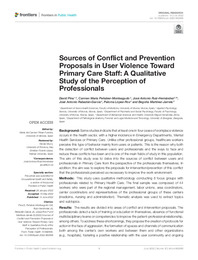Por favor, use este identificador para citar o enlazar este ítem:
https://hdl.handle.net/11000/34425Registro completo de metadatos
| Campo DC | Valor | Lengua/Idioma |
|---|---|---|
| dc.contributor.author | Pina, David | - |
| dc.contributor.author | Peñalver Monteagudo, Carmen María | - |
| dc.contributor.author | Ruiz-Hernández, José Antonio | - |
| dc.contributor.author | Rabadán, José Antonio | - |
| dc.contributor.author | López Ros, Paloma | - |
| dc.contributor.author | Martínez Jarreta, María Begoña | - |
| dc.contributor.other | Departamentos de la UMH::Ciencias del Comportamiento y salud | es_ES |
| dc.date.accessioned | 2025-01-11T16:51:49Z | - |
| dc.date.available | 2025-01-11T16:51:49Z | - |
| dc.date.created | 2022-06-15 | - |
| dc.identifier.citation | Frontiers in public health. 2022 Jun 15:10:862896 | es_ES |
| dc.identifier.issn | 2296-2565 | - |
| dc.identifier.uri | https://hdl.handle.net/11000/34425 | - |
| dc.description.abstract | Background: Some studies indicate that at least one in four cases of workplace violence occurs in the health sector, with a higher incidence in Emergency Departments, Mental Health Services or Primary Care. Unlike other professional groups, healthcare workers perceive this type of behavior mainly from users or patients. This is the reason why both the detection of conflict between users and professionals and the ways to face and reduce these conflicts has been and is one of the main fields of study in this population. The aim of this study was to delve into the sources of conflict between users and professionals in Primary Care from the perspective of the professionals themselves. In addition, the aim was to explore the proposals for intervention/prevention of this conflict that the professionals perceived as necessary to improve the work environment. Methods: This study uses qualitative methodology conducting 8 focus groups with professionals related to Primary Health Care. The final sample was composed of 44 workers who were part of the regional management, labor unions, area coordinators, center coordinators and representatives of the professional groups of these centers (medicine, nursing and administration). Thematic analysis was used to extract topics and subtopics. Results: The results are divided into areas of conflict and intervention proposals. The professionals detect a lack of training or education in themselves, absence of functional multidisciplinary teams or competencies to improve the patient-professional relationship, among others. To address these shortcomings, they propose the creation of protocols for action in the face of aggression, the formation of spaces and channels of communication both among the center’s own workers and between them and other organizations (e.g., hospitals), fostering a positive relationship with the user community and ongoingtraining in various topics such as self-safety, management of emotions, empathy or interpersonal communication. Conclusions: This study allows to highlight specific areas of user-professional conflict in Primary Care. Furthermore, the inclusion of intervention proposals by the professionals allows to propose starting points for the development of complete plans. | es_ES |
| dc.format | application/pdf | es_ES |
| dc.format.extent | 12 | es_ES |
| dc.language.iso | eng | es_ES |
| dc.publisher | Frontiers Media | es_ES |
| dc.rights | info:eu-repo/semantics/openAccess | es_ES |
| dc.rights.uri | http://creativecommons.org/licenses/by-nc-nd/4.0/ | * |
| dc.subject | health care violence | es_ES |
| dc.subject | user violence | es_ES |
| dc.subject | sources of conflict | es_ES |
| dc.subject | prevention proposal | es_ES |
| dc.subject | qualitative study | es_ES |
| dc.title | Sources of Conflict and Prevention Proposals in User Violence Toward Primary Care Staff: A Qualitative Study of the Perception of Professionals | es_ES |
| dc.type | info:eu-repo/semantics/article | es_ES |
| dc.relation.publisherversion | 10.3389/fpubh.2022.862896 | es_ES |

Ver/Abrir:
Sources of Conflict and Prevention Proposals in User Violence Toward Primary Care Staff A Qualitative Study of the Perception of Professionals.PDF
574,27 kB
Adobe PDF
Compartir:
 La licencia se describe como: Atribución-NonComercial-NoDerivada 4.0 Internacional.
La licencia se describe como: Atribución-NonComercial-NoDerivada 4.0 Internacional.
.png)